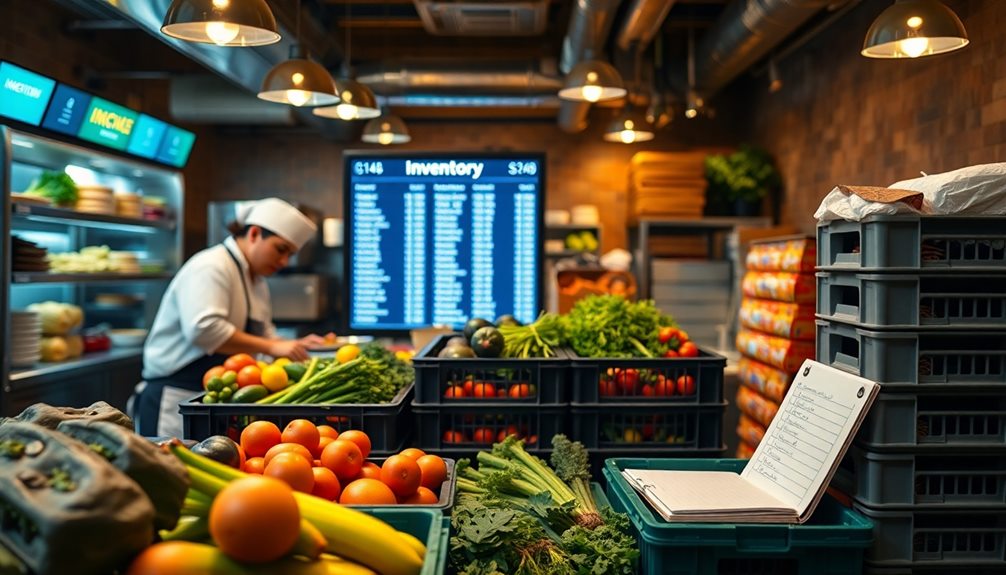Restaurants manage inventory by closely monitoring stock levels and aligning them with customer demand. You'll find they use inventory management software to streamline their operations and reduce waste. Implementing regular audits keeps everything accurate and minimizes theft or spoilage. Techniques like FIFO guarantee older items get used first to maintain freshness. Keeping an eye on sell-through rates helps identify which items are thriving and which aren't moving. With strategic inventory practices, restaurants enhance profitability and efficiency. If you explore further, you can uncover more tips and best practices in inventory management.
Key Takeaways
- Restaurants utilize inventory management software to track stock levels, streamline operations, and enhance accuracy in inventory counts.
- Regular audits are conducted to uncover discrepancies and foster accountability among staff regarding stock levels.
- The FIFO method is implemented to ensure older stock is used first, minimizing spoilage and maintaining product freshness.
- Analyzing sell-through rates helps restaurants make informed decisions on purchasing and managing slow-moving stock effectively.
- Establishing par levels prevents overstocking, ensures enough inventory is on hand, and balances customer demand with waste reduction.
Understanding Inventory Management
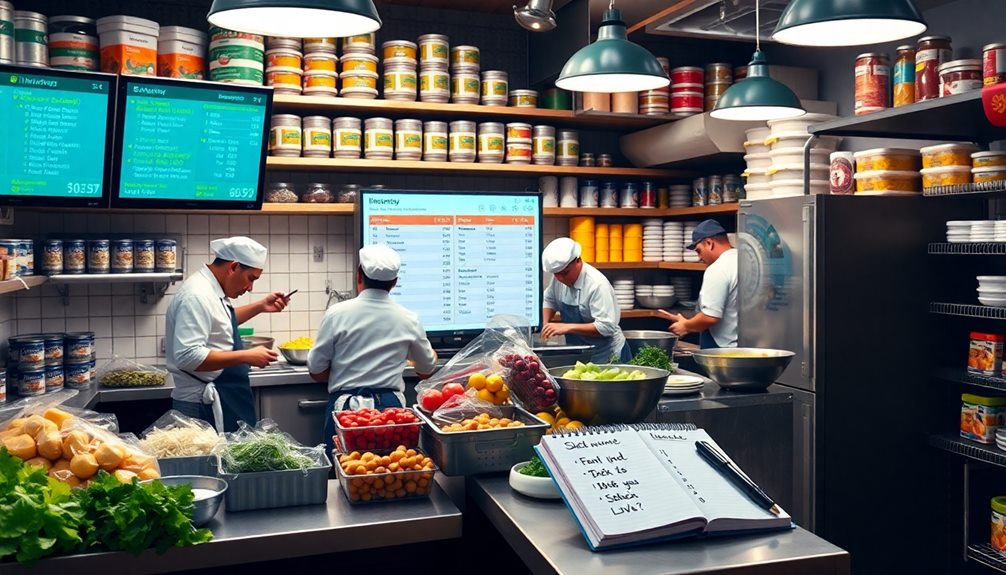
Understanding inventory management is vital for running a successful restaurant, as it directly affects your bottom line. In the restaurant industry, effective inventory management involves overseeing stock levels, ordering schedules, and tracking food from suppliers to usage. This process is important due to the perishable nature of food items, which can greatly impact your food costs and profit margins, typically representing 28%-35% of total expenses.
Using inventory management software can enhance the accuracy of your inventory tracking, providing valuable financial insights and streamlining operations. Implementing standardized inventory procedures and conducting regular audits help prevent discrepancies and reduce waste, which can account for as much as 5% of food costs.
Additionally, adopting techniques like FIFO (First In, First Out) for perishables guarantees that older stock is used first, minimizing spoilage and maintaining product freshness.
Importance of Effective Management
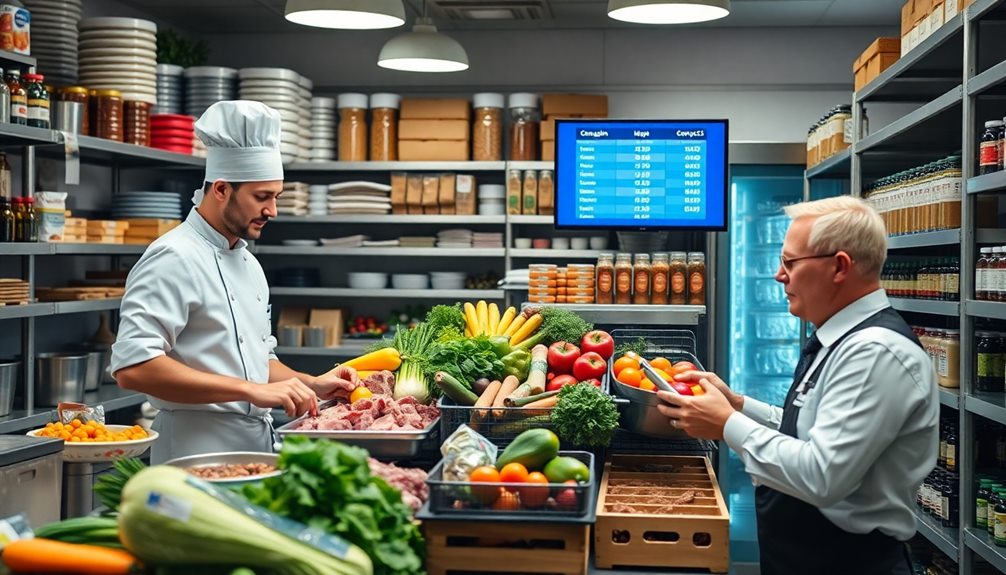
Recognizing the importance of effective inventory management can transform your restaurant's profitability and operational efficiency. Food costs often represent 28%-35% of your total expenses, so precise tracking and control are essential. By implementing efficient inventory practices, you can reduce waste and save up to 10% in costs, boosting your bottom line considerably.
Maintaining adequate stock levels is critical for ensuring customer satisfaction. When your menu items are consistently available, you retain clientele and foster loyalty.
Regular inventory audits not only help you identify discrepancies but also enhance accountability, ultimately reducing losses from theft or spoilage.
Utilizing automated systems for inventory management streamlines your processes, giving you better financial insights for decision-making. This technology can optimize stock levels and maintain healthy cash flow.
When you invest in effective inventory management, you're not just monitoring supplies; you're actively driving your restaurant's success.
Inventory Tracking Techniques
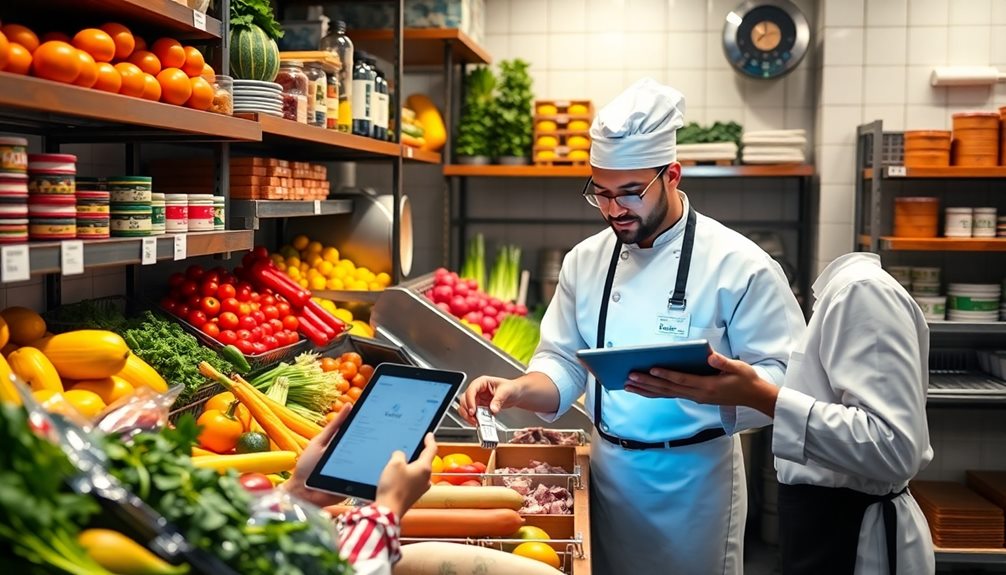
To keep your restaurant running smoothly, it's essential to adopt effective inventory counting methods. To keep your restaurant running smoothly, it’s essential to adopt effective inventory counting methods. Regularly tracking stock levels can help prevent shortages and reduce waste, ensuring your kitchen operates efficiently. Additionally, combining this with smart restaurant reservation management tips, such as staggering bookings during peak hours, allows for better planning and alignment between inventory and customer demand, creating a seamless dining experience.
By analyzing sell-through rates, you can make informed decisions about what to stock based on actual sales trends.
These techniques not only help you manage inventory more efficiently but also reduce waste and maximize profits.
Inventory Counting Methods
Effective inventory counting methods are essential for restaurants aiming to maintain accurate stock levels and minimize discrepancies. One popular technique is cycle counting, where you regularly count specific items on a scheduled basis, guaranteeing accuracy and reducing errors.
The shelf-to-sheet method is another valuable approach, allowing you to count inventory directly from shelves and record quantities on a pre-prepared sheet, which helps minimize mistakes.
Utilizing a point-of-sale (POS) system enhances your ability to track sales trends and inventory depletion in real time. This technology supports accurate forecasting and ordering, helping you align stock management with customer demand.
Establishing par levels for minimum stock guarantees you always have enough inventory on hand while preventing overstocking and waste.
To reinforce accountability and accuracy in your inventory counts, conduct regular audits and invest in staff training on inventory procedures. Well-trained staff will understand the importance of these methods, enhancing overall efficiency.
Sell-Through Rate Analysis
Understanding your sell-through rate can greatly impact your restaurant's inventory management. This rate is calculated by dividing the number of units sold during a specific period by your total inventory available at the start of that period.
To effectively manage your inventory levels, you should regularly analyze sales data, ideally on a weekly or monthly basis. A healthy sell-through rate for food items typically ranges from 20% to 30%, suggesting strong product demand.
By monitoring your sell-through rates, you can identify high-performing items on your menu and make informed decisions about slow-moving stock, ultimately helping you reduce waste.
Utilizing POS systems for real-time tracking of sales and inventory levels enhances the accuracy of your calculations, allowing you to make timely decisions regarding reordering and menu adjustments.
This proactive approach to sell-through rate analysis not only optimizes your inventory management but also guarantees that you're meeting customer demand efficiently.
Best Practices for Management
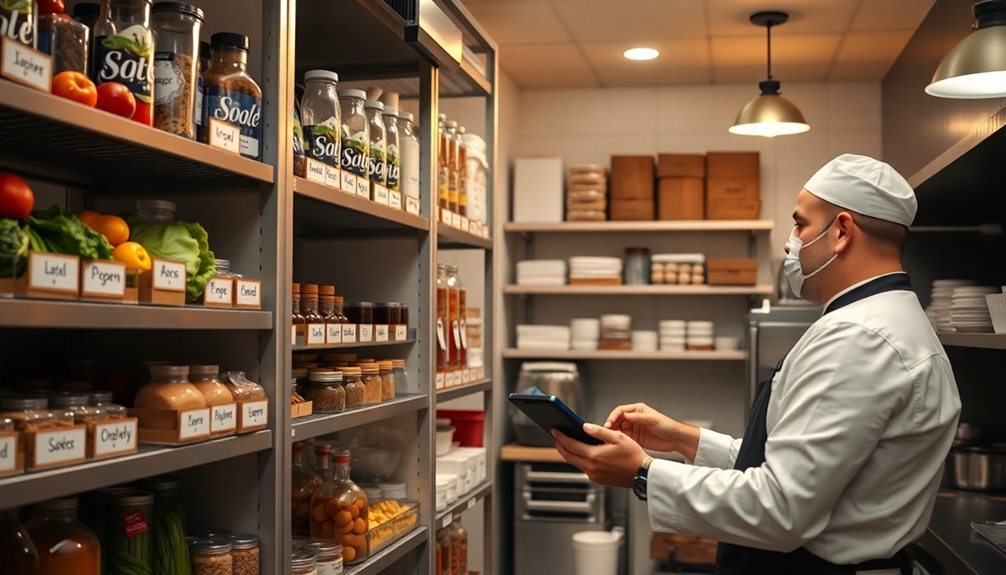
Successful restaurant inventory management hinges on adopting best practices that enhance accuracy and efficiency. Start by implementing regular audits of your inventory. These audits can uncover discrepancies and foster accountability among staff, leading to more accurate stock levels and reduced food waste.
Utilize the First In First Out (FIFO) method to guarantee older stock gets used before newer items, minimizing spoilage of perishable goods. Establishing par levels is essential too. By maintaining ideal stock levels, you can meet customer demand without over-ordering and accumulating excess inventory.
To further streamline your inventory tracking processes, consider leveraging inventory management software. This allows for automated inventory management, giving you real-time data insights that improve operational efficiency and cost control.
Don't underestimate the importance of staff training. Properly training your employees on inventory handling and documentation is fundamental for cultivating a culture of accountability. When your team understands the significance of accurate inventory management, it helps minimize losses and guarantees smoother operations.
Technology in Inventory Control
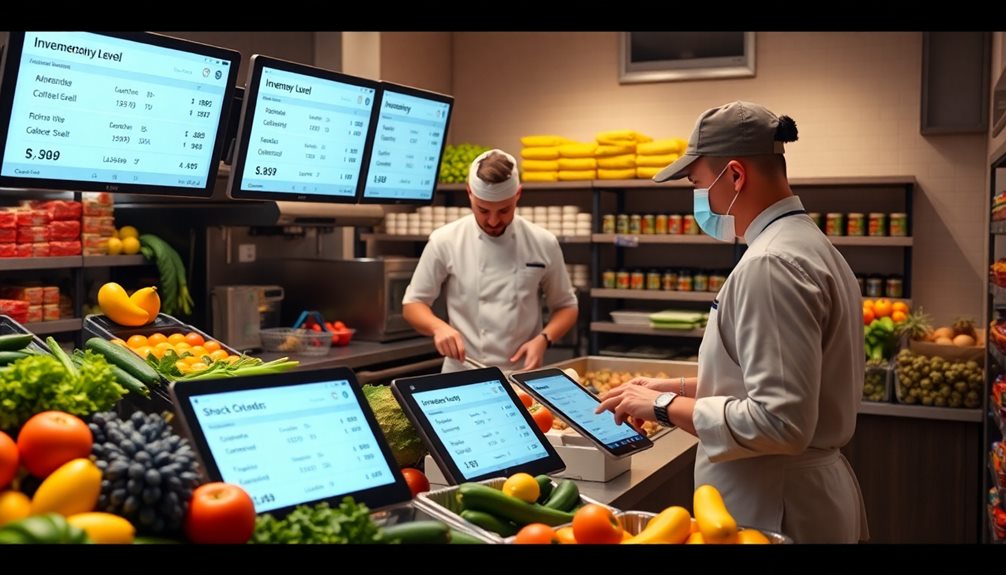
When it comes to managing your restaurant's inventory, automated tracking systems can be a game changer.
These tools not only keep you updated on stock levels but also help you forecast demand based on real data.
Automated Inventory Tracking Systems
In today's fast-paced restaurant environment, efficient inventory management is crucial for maintaining profitability, and automated inventory tracking systems are revolutionizing the way restaurants handle stock.
These systems leverage real-time data to monitor stock levels, considerably reducing human error and improving accuracy in inventory counts. By integrating with Point of Sale (POS) systems, you can analyze sales trends and forecast future inventory needs based on historical data and seasonality.
Additionally, utilizing smart technology in your operations, similar to home security systems, can enhance your overall efficiency and safety.
Here are four key benefits of automated inventory tracking systems:
- Automated Reordering: Generate purchase orders automatically when stock levels dip below predefined par levels, streamlining replenishment.
- Mobile Inventory Management Apps: Conduct inventory counts on-the-go, making it easier to manage stock without disrupting operations.
- Reduced Food Waste: Implementing these systems can lead to a potential reduction in food waste by as much as 10%.
- Major Cost Savings: By maintaining optimal stock levels and minimizing waste, you enhance your bottom line.
With automated inventory tracking systems, you can stay ahead of your inventory challenges and guarantee your restaurant operates efficiently and profitably.
Data-Driven Demand Forecasting
Data-driven demand forecasting is transforming how restaurants manage their inventory by leveraging valuable insights from historical sales data and seasonal trends. By analyzing customer purchasing patterns, you can predict future inventory needs more accurately, ensuring ideal stock levels.
This not only reduces the risk of stockouts but also minimizes food waste, with restaurants seeing up to a 10% reduction by adjusting procurement strategies based on forecasted demand.
Advanced POS systems equipped with predictive analytics tools enhance your inventory turnover rates, aiming for the industry target of 4-6 turns per month.
When you implement automated demand forecasting, you're able to align your stock levels with expected sales more effectively. This leads to better cash flow management, as informed purchasing decisions help you avoid unnecessary spending on excess inventory.
Managing Food Costs
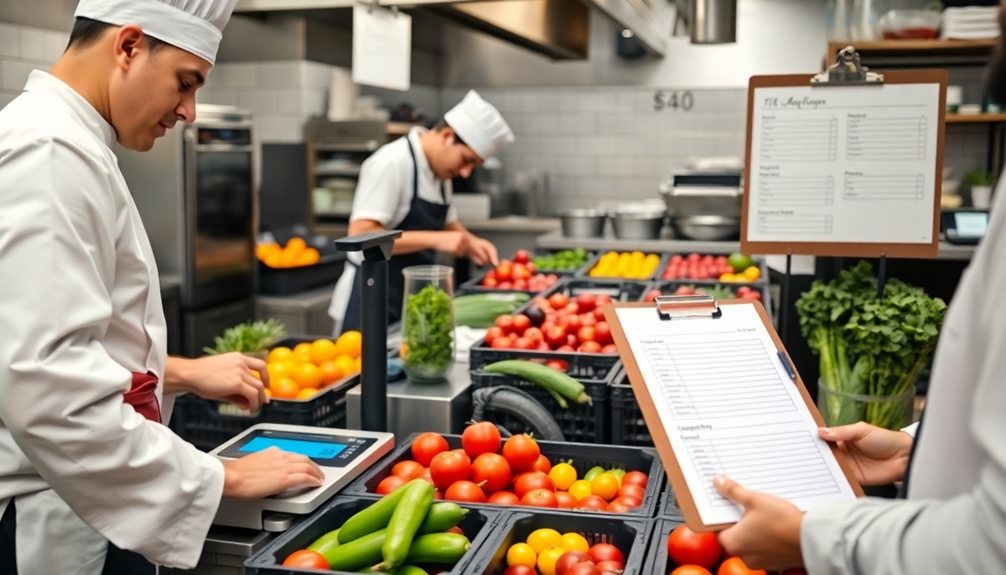
Effectively managing food costs is essential for any restaurant aiming to boost profitability. Food costs typically make up 28%-35% of total expenses, so you need to keep a close eye on them.
Here are four key strategies to take into account:
- Accurate CoGS Calculations: Regularly assess your Cost of Goods Sold (CoGS) to set appropriate menu prices. A 36% food cost percentage can guide your pricing strategy effectively.
- Implement FIFO: Use the First In, First Out (FIFO) method for perishables. This minimizes spoilage and helps maintain ideal stock levels that align with customer demand.
- Conduct Inventory Counts: Regular audits and inventory counts can reveal discrepancies. This attention to detail can save you an average of 24% annually by preventing waste and over-ordering.
- Track and Analyze Inventory: Use data analysis to track inventory usage and sell-through rates. This allows you to forecast future needs, leading to informed purchasing decisions and better overall inventory management.
Strategies for Reducing Waste
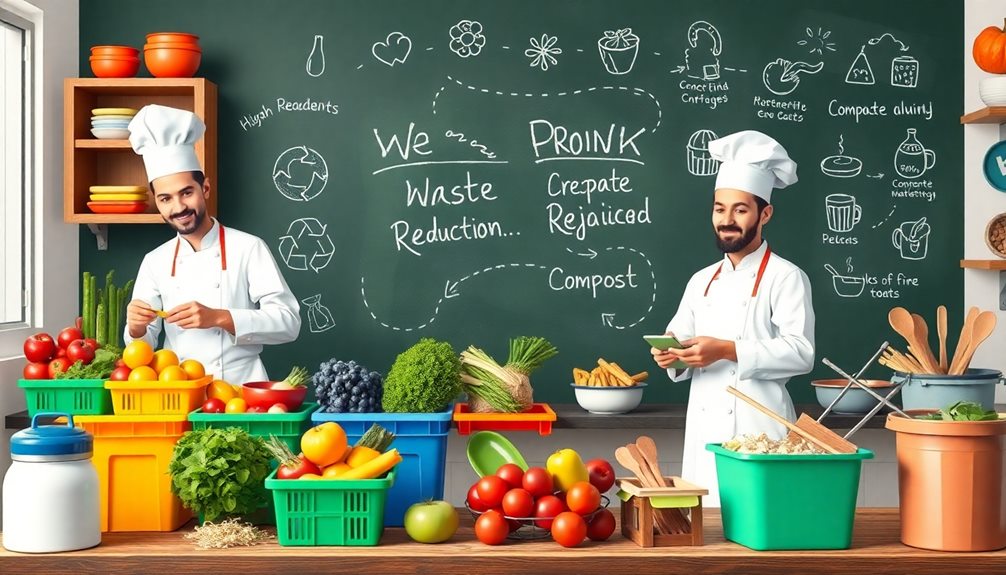
Reducing waste is vital for enhancing a restaurant's profitability and sustainability. One effective strategy is implementing the FIFO (First In, First Out) method, which guarantees older stock is used first, minimizing spoilage and waste.
Regular inventory audits help you identify overstocked items and dead stock, allowing you to adjust your purchasing habits accordingly.
Training your staff on portion control and waste reduction techniques is important. When everyone understands proper measurements, it leads to ideal ingredient usage and less food waste.
Additionally, using inventory management software can automate tracking and highlight food waste patterns, giving you valuable insights to adjust your menus and inventory levels.
Establishing par levels for inventory items guarantees you maintain enough stock to meet customer demand without over-ordering. This balance further reduces the likelihood of excess waste.
By utilizing these strategies, you can create a more efficient operation that not only saves costs but also contributes to a more sustainable environment.
Focus on these practices, and you'll see a significant reduction in waste, benefiting both your bottom line and the planet.
Frequently Asked Questions
What Is Inventory Management in a Restaurant?
Inventory management in a restaurant involves tracking stock levels, controlling costs, and reducing waste. You'll monitor food and beverage supplies, ensuring menu items are available while optimizing profit margins through effective practices and technology.
How Do Restaurants Keep Track of Food Inventory?
Imagine a finely tuned orchestra, where each note matters. You keep track of food inventory by using software for real-time updates, performing daily counts, and analyzing sales data to guarantee everything's in harmony and fresh.
What Is the Best Inventory Method for Restaurants?
The best inventory method for you is FIFO, ensuring older stock gets used first, reducing spoilage. Consider FEFO for perishables, and leverage software for real-time tracking and efficient reordering to maintain ideal stock levels.
How Do Restaurants Calculate Inventory?
Counting and calculating inventory's essential. You'll conduct physical counts regularly, track stock systematically, and utilize software for seamless scanning. By analyzing usage reports, you'll maintain ideal stock levels and guarantee smooth service without shortages.
Conclusion
In the bustling kitchen, every ingredient counts, yet so often, precious food goes to waste. By mastering inventory management, you not only save money but also honor the hard work of farmers and suppliers. It's a delicate balance between abundance and scarcity, where mindful practices can transform excess into opportunity. Embrace technology and best practices, and you'll not just manage inventory—you'll create a sustainable future, turning the tide from wastefulness to gratitude in your restaurant.
